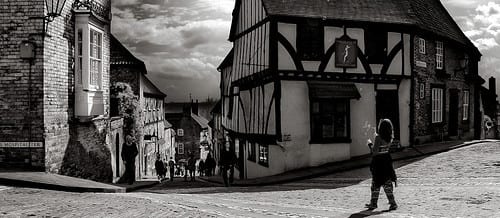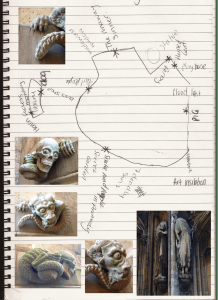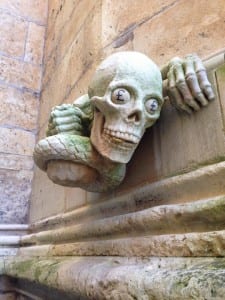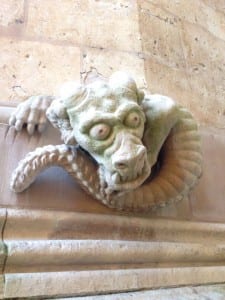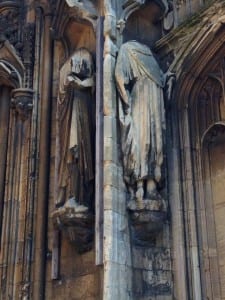During Monday’s lesson the weather was far from perfect. The wind and rain encouraged us to take our research undercover. We knew that we wanted our site to be around the cathedral so we headed into the cathedral to see if we could overhear some conversations about its history or local myths, as our original performance idea involved verbatim. Whist in there we visited the chapter house, of which the architecture blew me away. Whilst gazing into the phenomenal structure of the building a father and his two young children came bombarding in, with booming voices that caught the acoustics brilliantly. The father was telling his children about the history of the building and how it was used for conferences and debates. However the youngest child wasn’t interested at all and continued to run around shouting and seeing if their voice made an echo. This made us think about the difference in perceptions regarding age. What an adult may see in a building (a structure of history), a child may see something very different (a room to make your voice sound big). We then sat and talked more about this idea of seeing things differently and realised that the cathedral has so many layers of perception to it. We really like the idea of perceptions that weren’t overly thought about. Fictional stories that people think of when they immediately see a site or object. This then brought us back to the Gargoyles that we saw. The facts of why they are there are rarely know, thus people create varying myths and stories about their presence. No two stories are the same; therefore the layers begin to appear.
Tag Archives: Gargoyles
Misguides and gargoyles
This weeks tasks had me really engaging with the idea of guides; an idea that I unexpectedly enjoyed. One of the tasks that we were given was to create a map, any type of map, but it had to be unconventional. My partner and I wandered around the cathedral, drawing freehand lines in correspondence to where we walked. We were originally going to recreate the shape of the map with objects we found on our walk. However we were then rapidly distracted when we found controversial gargoyles. This then took us onto a completely different track, and we then started to mark down on the map where the controversial and simply out of place gargoyles were on the cathedral. Within his book Mythogeography, Phil Smith stated that ‘after a while certain things may begin to connect and once that starts happening, without obsessively pursuing a story, you can begin, collectively, to ‘compose’ your drift, allowing what has happened so far to determine your next choices’ (Smith, 2010, 199). This slight tangent that we allowed our drift to go on meant that we developed something that truly interested us, something that was inspired purely from the site itself. I particularly like the idea of a misguide around the cathedral, creating elaborate storied about why and how theses particular statues are here. Allowing people to look beyond the typical tourist view of the cathedral, and discover new information about a place they may have thought they knew so well. Below is the map we drew and some photos of the gargoyles we found on our journey.
As well as experiencing this oddly enlightening drift around the cathedral, we also explored the misguide. Despite finding this exercise difficult at first, it turned out extremely fun and interesting, both as ‘performer’ and audience. Although the facts aren’t true, the audience are shown a new and sometimes outrageous perception of a place. For example there were several misguides that took place, all with brilliant ‘stories’. Each one brought a new perception to the area around where St Paul in the Bail church once stood, and ultimately I’ll now see that place in a completely different light.
Smith, P. (2010) Mythogeography: A Guide to Walking Sideways. Devon: Axminster Triarchy Press.
